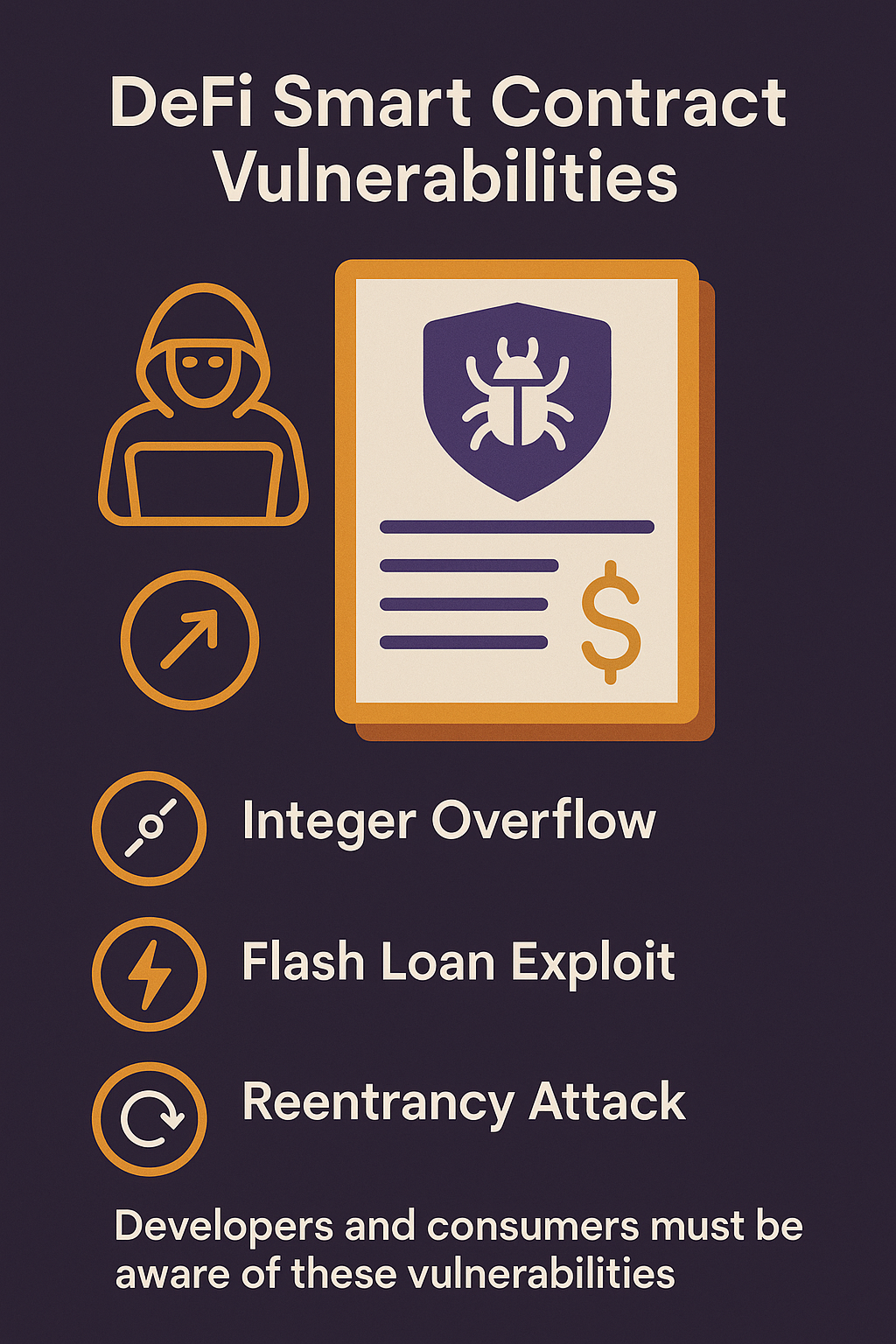Defi smart contract vulnerabilities, smart contract exploits, their effects, mitigation strategies, and mitigation strategies are all covered in this article.
Smart contract exploits

Vulnerabilities or defects in smart contract programming that an attacker could employ to inflict monetary or functional harm are known as smart contract exploits. These exploits may result in a number of adverse consequences, such as money theft, service interruptions, or contract behavior modification.
Because a smart contract’s code becomes immutable that is, unchangeable once it is implemented on a blockchain, smart contract flaws are very serious. This immutability emphasizes the vital need of security by making any vulnerabilities or defects permanently implanted and challenging to fix. Blockchain technology is widely considered safe due to its tamper-evident and tamper-resistant nature, however new applications like smart contracts may have problems. These errors are often caused by human error in coding, language-level faults in smart contract programming languages, or Ethereum Virtual Machine execution paradigm difficulties.
Defi smart contract vulnerabilities

Decentralized finance (DeFi) smart contract vulnerabilities are flaws in the code of DeFi applications that bad actors could use to steal money or control the system. Integer overflows, flash loan exploits, and reentrancy attacks are examples of common vulnerabilities. To reduce dangers in the DeFi area, developers and consumers alike must be aware of these vulnerabilities.
The following are some typical vulnerabilities and exploits for smart contracts:
Reentrancy Attacks
This happens when an attacker repeatedly invokes a contract function before the preceding call finishes, which could result in the loss of money. In example, the attacker can frequently call back into the original function before its initial execution is finished by calling an external contract or function, which is especially dangerous in Ether withdrawal functions. One well-known instance is the Decentralized Autonomous organization(DAO) hack in 2016, in which an attacker was able to syphon off over $50 million worth of Ether by repeatedly taking money out of the contract before its balance could be updated due to a recursive call flaw. This can be fixed by changing the account balance prior to starting the payout.
Integer Overflow/Underflow
These faults occur when integer type arithmetic operations go below (underflow) or above (overflow), causing the value to wrap around to the other end of its range and allow manipulation and unexpected results. If an uint variable stores a negative value, it will wrap around to its maximum. An example of an overflow that enables a hacker to move a significant quantity of tokens from a contract is the Beauty Chain vulnerability.
Front-running Attacks
To obtain an edge, attackers take advantage of the predictable transaction order. This happens as a result of transactions being kept in a public memory pool prior to being incorporated into a block. The behavior of a smart contract can be influenced by a malevolent user who keeps an eye on these pending transactions and submits their own transaction with a larger petrol fee to have it performed first.
Denial of Service (DoS) Attacks
By consuming resources, these attacks seek to render the contract useless or unavailable, hence blocking the processing of valid transactions. Among the examples are:
- DoS with unexpected revert: In smart contract auctions, malicious bidders can make sure that refunds to their address never happen, denying other people the opportunity to win.
- DoS with block gas limit: By deploying smart contracts that are very costly to run, attackers can use up all of the gas available and stop subsequent transactions from being processed.
- Insufficient gas griefing: When a contract makes a sub-call to another contract that restricts the sent gas, an attacker can send transactions with a low gas amount, causing them to fail.
When contracts use manipulable external data sources like oracles, attackers can change contract logic and steal money. Even with secure and checked smart contract code, an erroneous or modified oracle feed can lead it to run unexpectedly. Fulcrum exploited Oracle with a flash loan on February 15, 2020, collecting a huge payout.
Access Control Vulnerabilities
Unauthorized users may be able to carry out operations and alter contract data or payments due to inadequate or nonexistent access control measures.
Logic Mistakes
These weaknesses, which can be used to get around intended behavior and affect finances, are frequently the result of poor contract design.
Dependency on Timestamps
Block timestamps can be changed by attackers to affect how contracts are executed, which could have unexpected repercussions. A rogue miner can select an appropriate timestamp to exploit this vulnerability if contract operations are allowed based on block timestamps.
Consequences of Smart Contract Exploits
In some smart contract designs, it can be problematic for an attacker to deliver Ether to a contract without activating its fallback function.
Call to the Unknown
This might occasionally result in unexpected fallback function execution when a smart contract invokes a function from an invalid contract.
Gasless Send
The recipient’s fallback function only receives a tiny gas stipend when Ether is transmitted from Solidity code using the transfer technique. The transfer will fail if the fallback function uses more gas than this stipend.
Exception Disorders
The security of smart contracts may be compromised by irregular exception execution.
Type Cast Errors
When calling functions in other interfaces, Solidity compilers might not recognize type problems, which could result in undesirable outputs if the caller is not aware of them.
Ether Lost in Transfer
Cryptocurrency (Ether) is permanently lost if it is sent to an address that is part of a “orphan node” an address that does not have a private key for recovery.
Stack Size Limit Exploitation
The maximum call stack depth of the Ethereum Virtual Machine (EVM) is 1,024 frames. Certain instructions, such as transmit or call, may fail if this limit is reached during contract execution, resulting in non-payment of cash. The EIP 150 hard fork resolved this problem.
Unpredictable State
Update problems may arise because users are not always able to predict the eventual state of a smart contract when they send a transaction.
Generating Randomness Vulnerabilities
Malicious miners might influence smart contracts that use predictable sources, such as future timestamps or block hashes, to generate pseudo-random numbers (for games or lotteries, for example) in order to skew results in their favor.
Parity Wallet Hacks
An attacker was able to take advantage of a “fallback function” in 2017 by invoking an initWallet function that was present in the helper library but absent from the wallet due to a flaw in Parity’s multi-signature wallet library contract. This resulted in a $30 million loss since the attacker was able to seize control of the library contract and embezzle money.
In a later occurrence, an inexperienced developer unintentionally executed a self-destruct code in a library contract, permanently locking millions of dollars’ worth of Ether in hanging wallet contracts.
Mitigation Strategies
Smart contract exploitation have serious and wide-ranging repercussions:
- Financial Losses: As seen by multiple high-profile hacks, the most obvious effect is the loss of money held by the contract.
- Loss of Trust: Smart contract vulnerabilities undermine confidence in the safety of blockchain technology and decentralized finance (DeFi).
- Reputational Damage: Future development and acceptance of projects whose contracts are exploited are negatively impacted by their severe reputational harm.
- Hacking incidents may lead to stricter DeFi industry regulations and increased regulatory scrutiny.
- Trust erosion and regulatory load may stifle blockchain ecosystem innovation and growth.
Building reliable smart contracts requires knowing these vulnerabilities and using robust mitigation measures. Security audits, formal verification, secure coding techniques, gas optimization, the use of reliable oracles, frequent monitoring, and updates are examples of mitigation techniques. Before using smart contracts for production usage, careful planning, auditing, and extensive testing are essential due to these hazards.
